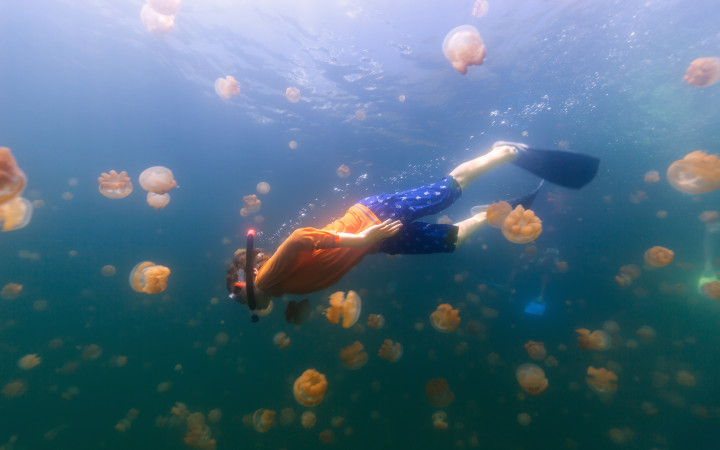Today’s Wonder of the Day was inspired by Rebecca from Groton, CT. Rebecca Wonders, “How do golden jellyfish survive in Lake Palau?” Thanks for WONDERing with us, Rebecca!
If you could travel anywhere in the world, what would you choose? Would you visit the top of the Eiffel Tower? Hike in a cave full of glowworms? Maybe you’d climb Mauna Kea. Or perhaps, you’d visit Jellyfish Lake!
Where is Jellyfish Lake? It’s on the Palau archipelago, about 400 miles (650 kilometers) north of New Guinea. This string of over 300 islands is home to beautiful beaches and unique plants and animals.
That includes the golden jellyfish, which can’t be found anywhere else in the world. It’s also one of the few species that live in lakes. Most of the world’s 200 types of jellyfish prefer to swim in the open oceans.
This may leave you WONDERing . . . how did the golden jellyfish come to live in a lake, anyway? To find that answer, we need to look back in time about 12,000 years. At that time, what we now know as Jellyfish Lake was connected to the Pacific Ocean. This was due to a rise in sea level following the last Ice Age.
When the sea level declined, land rose between Jellyfish Lake and the ocean. That’s when jellyfish were trapped in the lake, unable to return to the sea. In the millenia that followed, they evolved to their habitat. That’s how the golden jellyfish became a unique species.
What’s special about the golden jellyfish? Unlike many other species, these jellies have stingers so small that they can’t be felt by human beings. For that reason, people are actually able to swim in Jellyfish Lake alongside the jellyfish!
Golden jellyfish also have a unique relationship with their food source. In fact, some experts refer to them as farmers. The jellyfish feed on algae that actually live in their tissues. To help these algae grow, the jellies follow the path of the Sun each day. They swim across the lake, always staying in sunlit water to make sure the algae can grow through photosynthesis.
During their daily journey, the jellyfish must be careful to stay away from the shadowed edges of the lake. That’s where their main predator, the sea anemone Entacmaea medusivora, is found. If a jelly gets too close, anemones trap them. They then use their tentacles to hold the jellyfish close as they eat.
Just how many golden jellyfish live in Jellyfish Lake? In recent years, the population has fluctuated. Prior to 2016, an estimated 30 million jellies called the lake home. However, a strong El Niño nearly wiped out the entire species. Today, the lake contains around 700,000 jellyfish.
Today, 80 percent of the waters of Palau are protected as a marine sanctuary. This is the largest area of protected marine territory in the world. Scientists and the nation of Palau are hopeful that this measure will safeguard the islands’ vast biodiversity for centuries to come.
Would you like to swim in Jellyfish Lake? Wading among thousands of jellyfish must be an experience like none other! And it’s just one of the features that makes Palau a unique part of the world.
Standards: C3.D2.Geo.4, C3.D2.Geo.5, C3.D2.Geo.6, NGSS.LS1.A, NGSS.LS1.C, NGSS.LS2.A, NGSS.LS2.C, NGSS.LS4.C, NGSS.LS4.D, CCRA.R.4, CCRA.L.3, CCRA.L.6, CCRA.R.2, CCRA.R.10, CCRA.R.1, CCRA.L.1, CCRA.W.3, CCRA.SL.1, CCRA.L.2N, CAS.A.1, NCAS.A.2, NCAS.A.3




